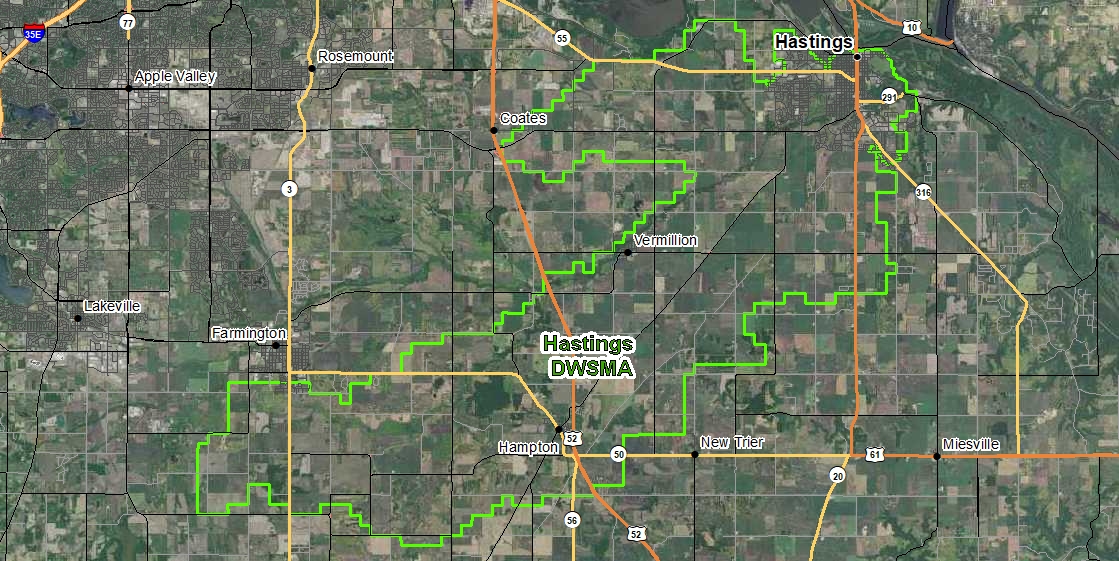
Under the Groundwater Protection Rule, a list of nitrogen fertilizer Best Management Practices (BMPs) and Alternative Management Tools (AMTs) to protect groundwater within the Hastings Drinking Water Supply Management Area (DWSMA) has been approved by the MDA and published in 2023.
The list of practices was developed by the MDA in consultation with the Hastings Local Advisory Team. The BMPs will need to be adopted on at least 80% of cropland acres (excluding soybean acres) within the DWSMA. AMTs can be voluntarily adopted and used to replace BMPs in certain situations. Going beyond the BMP list, a Hastings Nitrate Reduction Strategy includes additional options such as AMTs and increasing vegetative cover. Both documents can be found under "Forms + Resources"
The BMP list identifies practices for coarse and fine textured soils. An interactive map of the Hastings DWSMA is available to illustrate where coarse soils are present. Producers can use this map to consider which BMPs are applicable to the fields thy farm within the DWSMA.
Note that Part 1 of the Groundwater Protection Rule restricts the application of nitrogen fertilizer in the fall and on frozen soils in this DWSMA unless producers are following the exceptions to the rule.
After no less than three growing seasons following the publication of this list, the MDA will conduct an evaluation to determine if the BMPs or AMTs have been adopted in the Hastings DWSMA. If during this evaluation less than 80% of the cropland acres within the DWSMA have adopted the BMPs or AMTs listed, the DWSMA may be designated a Mitigation Level 3 and the adoption of BMPs will be required.
Due to elevated levels of nitrate-nitrogen, the Hastings DWSMA was listed at a Mitigation Level 2 under the Groundwater Protection Rule. To learn more about the determination process visit Mitigation Level Determination.
- Designated a mitigation level 2 on January 15, 2020 using the following criteria:
- One or more public wells have exceeded 8 mg/L nitrate within the past 10 years
- No point source of nitrate found to be the cause of the elevated nitrate level
(i.e., ag chemical incidents, animal feedlots, improperly sealed wells, etc.)
- The DWSMA is approximately 61,791 acres and is a high vulnerability area
- There are approximately 300 - 400 cropland owners and 100-150 operators within the DWSMA
- Located in Dakota County
- The MDA is currently developing a groundwater monitoring network within this DWSMA
- Of the 6 primary public wells, 1 has tested above 8 mg/L and 3 have tested above 10 mg/L within the past 10 years
The MDA established a Local Advisory Team (LAT), consisting of local farmers, agronomists and local government staff. Below is a list of milestones that were met during this process:
- The LAT has formed and is actively meeting
- Interviewed local ag retailers and farmers to gather information on the current nitrogen fertilizer management practices within the DWSMA
- Completed computer modeling of nitrate loss below the crop rooting zone within this DWSMA
- In consultation with the LAT, a list of BMPs and AMTs that are practicable and appropriate for protecting groundwater within this DSWMA has been developed and approved.
The LAT will continue to meet to review new public well nitrate data and discuss ongoing implementation of BMPs and AMTs within the DWSMA. The team will also discuss opportunities for technical and financial assistance that can help support implementation of practices.
Overview of the Nitrate Reduction Strategy in the Hastings DWSMA (YouTube)
This video summarizes four basic options for farmers to be compliant with Part 2 of the Groundwater Protection Rule within the Hastings Drinking Water Supply Management Area.

